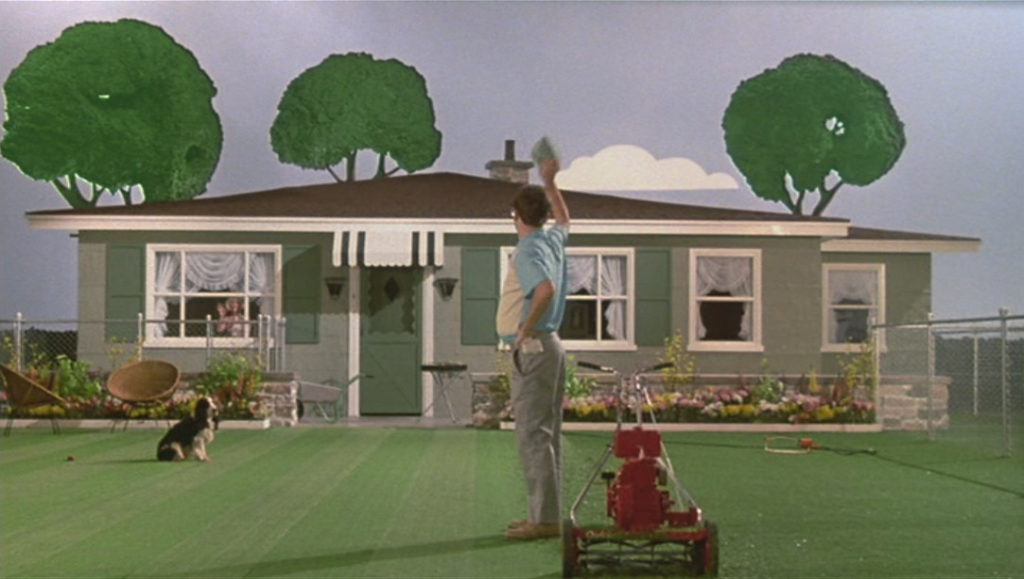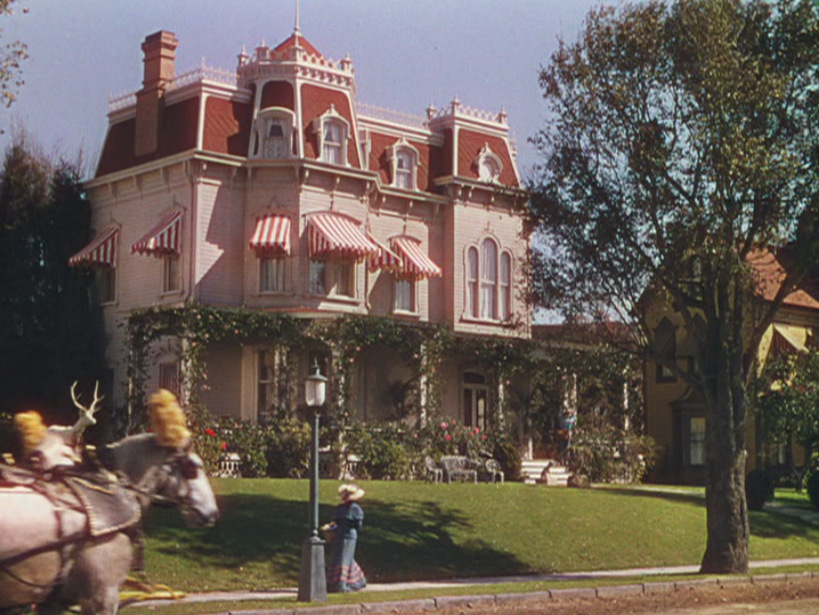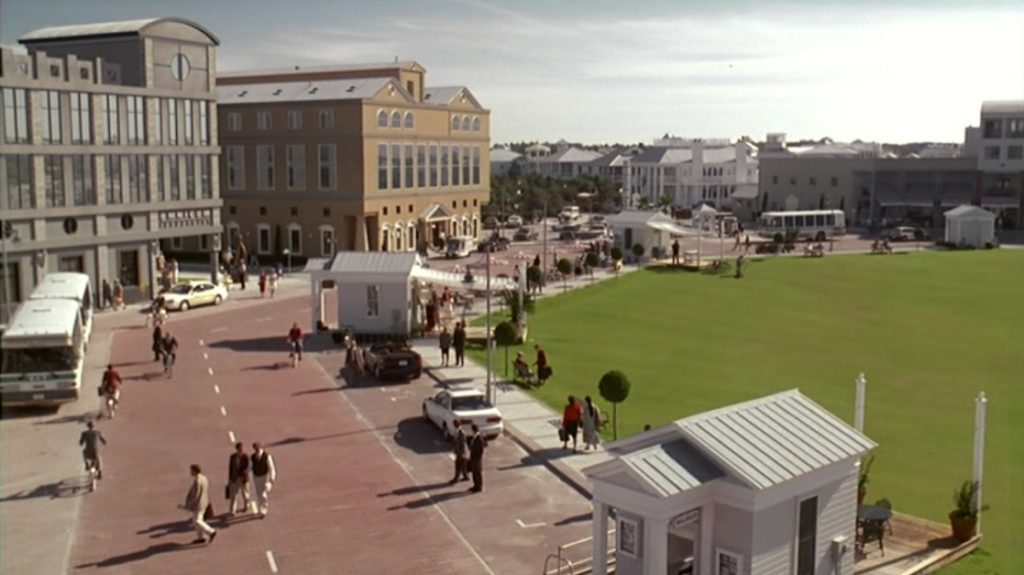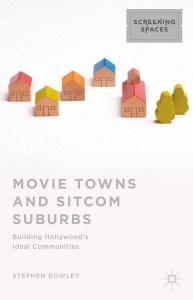Movie Towns and Sitcom Suburbs should be required reading for anyone who wants to explore the relationship between visual culture and urban theory in a rigorous manner… This is simply a benchmark work.
Jim Collins, Professor of Film and television at the University of Notre Dame

Movie Towns and Sitcom Suburbs: Building Hollywood’s Ideal Communities is my first book, published in October 2015 by Palgrave Macmillan.
The book ties together my interests in urban planning and cinema, looking at the depiction of cities and towns in film and TV, and considering the implications of such cultural imagery for urban planning practice. In November 2016 the book was awarded the Cutting Edge Research and Teaching Award at the Victorian Planning Institute Awards for Excellence.
Here’s the publisher’s blurb:
Media depictions of community are enormously influential on wider popular opinion about how people would like to live. In this study, Rowley examines depictions of ideal communities in Hollywood films and television and explores the implications of attempts to build real-world counterparts to such imagined places. He focuses on the ideals of small towns and suburbs featured during and shortly after World War II, tracking how these were an inspiration for post-World War II suburban development.
The depiction of cities in the cinema has received considerable attention in cinema studies since the 1990s. However, generally the work in this area has been done by film and cultural theorists (and, to a lesser extent, academic geographers). Given my background as a practicing planner, I was interested in exploring the feedback that occurs between how we view cities and towns in culture, and how we build communities in real life. While the book is still very much a work of cinema studies, my hope is that this perspective provides a distinct approach to this area of study.
The narrative of how conceptions of community changed in both popular culture and urban planning thought weaves throughout the book. Cultural depictions of cities and towns from film and television are examined, alongside actual built examples. I also consider hybrid spaces such as studio backlots and theme parks.

The following chapter outline gives a little more detail of what is covered.
Introduction: Visions of Community
A discussion of the links between urban planners’ conceptions of cities and towns and those that circulate in popular culture, including some discussion of how the interactions between real and imagined places occur.
Chapter 1: Movie Towns
A look at the classic imagery of the small-town movie as it circulated in Hollywood movies of the early 1940s. I talk about how these depictions of community anticipated the kinds of places that would be sought out after World War II. Major works discussed include It’s a Wonderful Life, Our Town, The Magnificent Ambersons, Kings Row, Shadow of a Doubt, and Meet Me in St Louis, amongst others.
Chapter 2: Sitcom Suburbs
A look at the depictions of community in classic 1950s sitcom, centering on Leave it to Beaver, Father Knows Best, and The Adventures of Ozzie & Harriet. I look at how these paralleled the explosive growth of suburbs in the early postwar era, and consider how the sitcom suburb differed from the movie town discussed in Chapter 1.
Chapter 3: The Bad Suburb
Because we think of sitcoms when we picture 1950s imagery of suburbs, it’s often assumed that the cultural depictions of suburbs in that era were always rosy. In this chapter I trace the strain of anti-suburban imagery in films starting from immediately after world War II and extending through to the 1980s. I parallel this with the rise of broader discontent with the realities of suburban life. Major works discussed include Mr Blandings Builds His Dream House, The Man in the Gray Flannel Suit, No Down Payment, All That Heaven Allows, The Swimmer, The Graduate, The Stepford Wives, and Poltergeist.
Chapter 4: The Fake Town
This chapter looks at the way media depictions crossed over into the construction of physical places. The places constructed and planned by Walt Disney are examined as examples of attempts to bridge the gap between ideals of community and everyday reality. I examine Disneyland and Disney’s ultimate planned town of EPCOT, and consider the way the reaction to these places has informed subsequent discussion about planned environments.
Chapter 5: Constructing the Movie Town
A look at the planning movement of the New Urbanism, considering the way that its imagery of community parallels the media-driven depictions of community discussed in earlier chapters. To what extent do these try to rediscover the same classic notions of community that are celebrated in film and television? I consider, in particular, two communities that have become inextricably intertwined with dialogues about fantasy spaces: the prototypical New Urbanist town of Seaside and the Disney-built community of Celebration.
Chapter 6: Deconstructing the Movie Town
If New Urbanist communities reflect deeply rooted cultural depictions of community, then surely this has helped aid their acceptance? I suggest it hasn’t been that simple. This chapter explores the criticisms of New Urbanist towns, and examines the cultural backlash against the picture-perfect planned community, as seen in films such as The Truman Show and Pleasantville.
Conclusion: The Perpetual Suburb
Given that the New Urbanists’ encounters with popular culture left them somewhat diminished, I conclude the study with a consideration of how urban planners might negotiate with media-driven ideals. I consider the explosion of anti-suburban depictions that has occurred since the late 1990s – including works such as The Ice Storm, Far From Heaven, Revolutionary Road, and Mad Men – and consider the way in the “bad suburb” has become normalised as somehow more “real” than other forms of community.

Reviews and Citations
Jim Collins, Professor of Film and television at the University of Notre Dame
Movie Towns and Sitcom Suburbs should be required reading for anyone who wants to explore the relationship between visual culture and urban theory in a rigorous manner. Rowley’s analysis of Disney’s envisioning of the ideal community – from animated entertainment to theme parks to planned communities – is distinguished by meticulous close readings and his theoretical sophistication. He moves so deftly across media because he constructs such elegant paradigms for comparative analysis. This is simply a benchmark work.
Dave Mercer, Associate Professor, RMIT University, writing in Australian Geographer:
This densely argued, scholarly text focuses on the way television and cinema in this period both presented images of idealised communities and also responded to growing criticisms of such movements as New Urbanism in the USA… This is a remarkable book and a work of extraordinary scholarship… The story he tells is not a straightforward one. There were always depictions of both ‘good’ and ‘bad’ suburbs and the “myth” of the congenial small town was often perpetuated in film long after the mass extinction of such places. As well, there were parallel debates going on in urban planning circles about “good” and “bad” urban design and the relative merits of the public and private spheres. What is of particular interest is the way in which the more admirable elements of close community ties and small town living never really disappeared in progressive urban planning circles and were also ruthlessly exploited in advertisements and sitcoms focusing on car-orientated suburban developments. Rowley weaves all these narratives together with consummate skill in what is in many ways a social history of the USA from the 1940s onwards. I cannot recommend this book highly enough.
From the citation for the 2016 PIA (Vic) Award for Planning Excellence (Cutting Edge Research and Teaching):
This work is an outstanding feat of scholarship… Movie Towns and Sitcom Suburbs offers a new perspective based on thorough research. It is a formidable academic work that is highly readable… The work is thought provoking about how community views are shaped, how planning seeks to influence day to day life, and how public opinion can be harnessed to guide and implement change.
Links
Here’s the Springer Link page – note this includes an option for a digitally printed paperback, which seems to be the cheapest way to get a physical copy. [Edit – this seems to only work if you have a university login – I am going to ask the publisher why this cannot be more universally available.]
